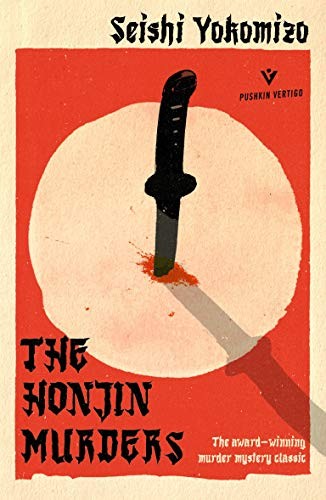Karen from AustCrime recenzis The Honjin Murders de Seishi Yokomizo
Review - The Honjin Murders
5 steloj
First published in 1946, the story is set in the winter of 1937, in the Japanese village of Okamura. Steeped in both the culture and sensibility of the time, THE HONJIN MURDERS is a classic of Japanese crime fiction, a locked room murder in the style of the Golden Age of crime fiction worldwide.
The grand, and influential family Ichiyanagi, are preparing for the wedding of the eldest son. It should be an auspicious event, but there is disquiet. The bride is the daughter of a fruit farmer, a lower class than the groom's Honjin family. Honjin is the Japanese word for an important inn, frequented only by government officials, they were originally places from which battles where directed by powerful generals. The families that ran these establishments gained influence and status by being granted official designations from the government, using their improved positions to create lavishly decorated and defended …
First published in 1946, the story is set in the winter of 1937, in the Japanese village of Okamura. Steeped in both the culture and sensibility of the time, THE HONJIN MURDERS is a classic of Japanese crime fiction, a locked room murder in the style of the Golden Age of crime fiction worldwide.
The grand, and influential family Ichiyanagi, are preparing for the wedding of the eldest son. It should be an auspicious event, but there is disquiet. The bride is the daughter of a fruit farmer, a lower class than the groom's Honjin family. Honjin is the Japanese word for an important inn, frequented only by government officials, they were originally places from which battles where directed by powerful generals. The families that ran these establishments gained influence and status by being granted official designations from the government, using their improved positions to create lavishly decorated and defended inns, in which general travellers were never permitted to stay.
The Ichiyanagi Honjin houses the now retired family matriarch, two of her sons, and one daughter, who is regarded as a "bit slow". The third son is a doctor in Osaka, and a second daughter lives in Shanghai. The "narrator" of the story fills in all members of the family, their position in Okamura, the difficulties the marriage is presenting and, eventually, some of the reasons for the eldest son choosing a bride who seems to be somewhat "inappropriate".
The family all live in the main, large house in the Honjin complex, with the annex or smaller dwelling in the grounds being setup as the home for the bride and groom. It is in this locked small house, on their wedding night, that the bride and groom are found murdered. In a strange sort of way, there's almost a sense of acceptance in some quarters that violent death has come to this mismatched pair. Happening on their wedding night is slightly disconcerting for all involved, but the thing that has everyone utterly confused, and considerably sobered, is that they died in what was effectively a securely locked room, with a bloody samurai sword thrust into the pristine snow outside the house. How, or who could possibly have caused such a violent, bloody death, with disruption in the room that they died in, and no obvious clues as to where a murderer could have been, or gone?
Given the time, and the strong sense of culture, the pace of this novel is slightly on the stately side. Travel is achieved mostly via train (some limited bus services), bicycles and walking. People have time to sit outside local drinking establishments and notice strangers. In this case they particularly notice two - a masked man asking questions, and the scruffy, other-worldly, amateur detective, Kosuke Kindaichi, who is called in to explain the impossible. Which is just as well, as the investigation is somewhat stalled by a kind, but slightly ineffectual policeman.
Wonderfully translated, THE HONJIN MURDERS proceeds at a pace which fits particularly well with the culture, location and standing of the central family. Around them is the village, from which they seem somewhat distant (on purpose), and various workers and assistants. The family has plenty of issues to be going on with - what with the sleepwalking sister and her dead kitten, the groom's past, the bride's present, and the amateur detective, called in by the bride's family. The plot here is classic locked room / impossible to commit, and it's constructed, analysed, and resolved based on deduction and careful observation, from an amateur sleuth who will go on to resolve 77 cases, although not all have been translated yet. Pushkin Vertigo has published English translations of The Inugami Clan (1951) and The Honjin Murders (1946) in 2020, The Village of Eight Graves (1951) in 2021, and Gokumon Island (?1971) in 2022.


